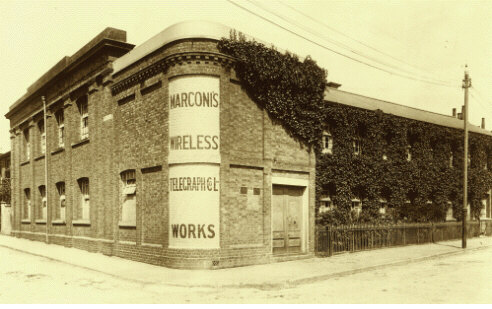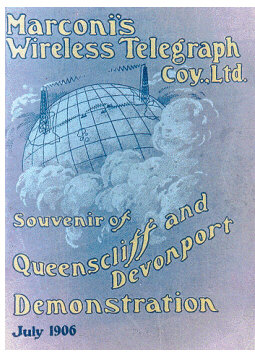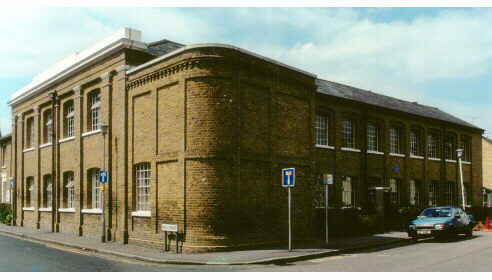
 | |||||||||
 |
1897 The Wireless Telegraph
and Signal Company Limited | |
 The first wireless factory, Hall St. Chelmsford. | ||
| In 1897 Marconi established communication across the Bristol Channel. These tests were conducted under the prevalent bad weather conditions. The record speaks of people huddled in huts on the beach to escape the storm. First attempts were unsuccessful but on the fourth day, with the aerial at 300 feet (92m) and using a 20 inch (0.5m) spark coil, a new record of 8.7 miles (14km) was achieved. The Morse message sent was 'let it be so'. | ||
| The Isle of Wight was the scene of many early Marconi experiments. In 1897 he set up an aerial and installed his apparatus in the grounds of the Royal Needles Hotel, Alum Bay, and succeeded first in communicating with a hired ferry boat, the S.S. Mayflower, and then with a station set up at Madeira House in Bournemouth. | ||
| There were many approaches to buy Marconi's patents. During the summer months of 1897 with the help of his cousin Henry Jameson Davis, the essential steps were taken to register his company. Known originally as the Wireless Telegraph and Signal Company, the name was changed later to Marconi's Wireless Telegraph Company Ltd., now GEC-Marconi Ltd. | ||
| Premises were needed for the new organisation. Marconi decided upon Chelmsford. A relatively short distance from London and accessible by rail, Chelmsford was an ideal location. In December 1898, the first wireless factory in the world was set up in an old silk factory in Hall Street. The building still stands today. | ||
| The success of Marconi's ever widening net of wireless communication played a dominant role in the development of broadcasting as entertainment, or radio as we know it. | ||
| The first life-saving possibilities of wireless were realised in 1899 when a wireless message was received from the East Goodwin lightship - which had been equipped with Marconi wireless apparatus. It had been rammed in dense fog by a steamship M.F. Matthews. A request was made for the assistance of a lifeboat. In 1910 it became mandatory to install wireless telegraphy apparatus on every large ship, with a competent telegraphist in attendance. With Marconi's apparatus aboard the ill-fated Titanic, a distress signal picked up by the German steamer Frankfurt on April 14th 1912, saved 705 lives. As Lord Samuel, Postmaster General at the time stated: 'Those who have been saved have been saved through one man, Mr. Marconi and.....his wonderful invention.' |  Publicity brochure cover 1906 | |
 Hall St. building, Chelmsford, 1997. Today, the Hall Street building is owned by the Essex & Suffolk Water Company but GEC-Marconi Companies maintain a strong presence in Chelmsford, namely the GEC-Marconi Research Centre, GEC-Marconi Communications Ltd., GEC-Marconi Radar and Defence Systems Ltd. and EEV Ltd  GEC-Marconi Radar and Defence Systems Ltd., Elettra House, Chelmsford, 1997. | ||
| 1894 - 1895
|
1896 - 1897 | 1897 The Telegraph and Signal Company Ltd. Chain of Events | Marconi ' The Man ' | Bibliography | ||
 |
|||||
| |||||